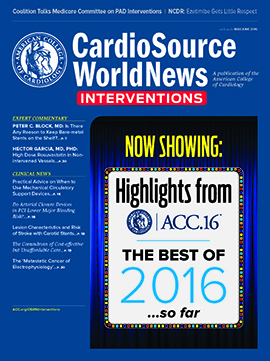Peripheral Matters: Coalition Addresses Medicare Committee on PAD Interventions | Mehdi H. Shishehbor, DO, MPH, PhD; Herbert D. Aronow, MD; and Michael R. Jaff, DO
CardioSource WorldNews Interventions | On July 22, 2015, a coalition of seven not-for-profit organizations ACC, Society for Cardiovascular Angiography and Intervention (SCAI), American College of Radiology (ACR), American Heart Association (AHA), Society of Interventional Radiology (SIR), Society for Vascular Medicine (SVM), and Vascular InterVentional Advances (VIVA), addressed the Medicare Evidence Development and Coverage Advisory Committee (MEDCAC) panel on interventions related to peripheral artery disease (PAD). This panel was initiated by the Centers for Medicare and Medicaid Services (CMS) to examine the scientific evidence on three categorical non-mutually exclusive interventions, namely, screening and medical therapy, exercise training, and revascularization (endovascular or surgical) on asymptomatic patients with PAD, intermittent claudication, and those with critical limb ischemia. The recommendations from this committee will be used by CMS for future determinations of CMS coverage for interventions related to PAD. Therefore, these recommendations will affect millions of Americans over the age of 65 years with PAD.
Subsequent to this meeting the coalition developed a document summarizing its position at the July MEDCAC meeting while outlining areas of evidence gap related to the treatment of PAD. This document has been endorsed by the ACR, SCAI, SIR, SVM, and VIVA, and now has been published simultaneously by Catheterization and Cardiovascular Interventions (CCI), Vascular Medicine (VM), and Journal of Vascular and Interventional Radiology.
PAD is associated with significant cardiovascular morbidity and mortality. Importantly a significant proportion of patients with PAD are asymptomatic. Unfortunately, the history and physical examination have significant limitations in identifying asymptomatic PAD. Therefore, the coalition recommends the ankle brachial index (ABI) as a diagnostic test for identifying individuals suspected of having PAD. Moreover, once PAD has been identified intensive medical therapy should be implemented to reduce the risk of cardiovascular morbidity and mortality.
Intermittent claudication, the most common symptom of PAD, should also be treated with intensive medical therapy. Supervised exercise training programs has been shown to be effective in multiple trials and should receive full coverage from CMS. It is our belief that no center of vascular excellence may exist without a comprehensive peripheral vascular rehabilitation program. Additionally, endovascular and open revascularization have a role in the management of intermittent claudication. Endovascular therapy in conjunction with supervised exercise walking is likely to be most effective approach and has been shown to improve maximum walking distance and initial claudication distance compared to each therapy alone. A number of randomized trials evaluating novel therapies such as drug-eluting stents (DES) and drug-coated balloons (DCB) in patients with claudication have also shown significant advances in treating individuals with intermittent claudication. Collectively, these advances will continue to impact millions of patients who suffer from PAD. Despite these advances though, there remains a knowledge gap regarding cost effectiveness and objective improvement in physical functioning. Moreover, there is little head-to-head data on the relative efficacy, safety, and cost of various medical, endovascular and surgical therapies.
Critical limb ischemia (CLI), the most severe and advanced form of PAD has been associated with amputation (of the index and contralateral limb), decreased quality of life, and increased mortality. Management of CLI is associated with substantial healthcare and societal costs, and these are expected to rise given the aging of the Medicare population and the expanding prevalence of diabetes mellitus and chronic kidney disease. Similar to those with asymptomatic PAD and intermittent claudication, CLI must be treated with intensive medical therapy including lifestyle modification and smoking cessation. However, the cornerstone of therapy for CLI and limb salvage is improving perfusion through revascularization. Indeed, all professional societies and guidelines consider revascularization as Class I. The optimal and best revascularization strategy must be tailored to each individual patient. Moreover, the coalition endorsed the concept of the CLI team, which may include endovascular and surgical specialists, wound, diabetes, infection care, and podiatric care.
The coalition highlighted significant disparities in revascularization rates by race, socioeconomic status, and geography, while underscoring the variability in amputation rates. In summary, the coalition looks forward to direct engagement with CMS to determine the best treatment options for patients with PAD. Ultimately, we must reduce the burden of cardiovascular morbidity and mortality associated with PAD and eliminate unnecessary amputations and health related consequences of PAD and CLI.

|
Read the full May/June issue of CardioSource WorldNews Interventions at ACC.org/CSWNI |
Keywords: Advisory Committees, American Heart Association, Angiography, Centers for Medicare and Medicaid Services, U.S., Intermittent Claudication, Medicaid, Medicare, Peripheral Arterial Disease, Radiology, Interventional, Societies, CardioSource WorldNews Interventions
< Back to Listings
